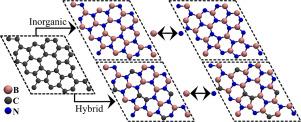无机和杂化类氮化石墨烯结构的结构、电子、动力学和光学性质
IF 5.1
3区 材料科学
Q2 MATERIALS SCIENCE, COATINGS & FILMS
引用次数: 0
摘要
我们研究了四种类azugraph烯单层膜的结构、电子、动力学和光学性质,包括两个纯无机结构和两个杂化硼碳氮(BCN)体系。进行第一性原理计算以获得结构和动力学性质,以及研究结构的电子和光学行为。地层能结果表明,这些新型材料在有利条件下具有较低的能量。平均温度为300 K的分子动力学模拟表明,所提出的结构可以承受热波动,突出了它们在环境条件下的潜在稳定性。声子计算进一步表明,其中一个结构沿整个k路径呈现负频率模式,因此是不稳定的。据估计,这些材料也具有很高的载流子迁移率,在稳定情况下,迁移率在~ 102 ~ ~ 104 cm2/V s之间。我们的光学结果表明,无机结构在光谱的红外和可见光区域没有明显的光学活性,而对于混合结构,活性在可见光范围内开始。此外,在研究的能量范围内,所有结构的反射率都低于7%。本文章由计算机程序翻译,如有差异,请以英文原文为准。

Structural, electronic, dynamical, and optical properties of inorganic and hybrid azugraphene-like structures
We investigate the structural, electronic, dynamical, and optical properties of four azugraphene-like monolayers, comprising two purely inorganic structures and two hybrid boron carbon nitride (BCN) systems. First-principles calculations were performed to obtain structural and dynamical properties, as well as to investigate the electronic and optical behavior of the structures. Formation energy results reveal that these novel materials have low energy under favorable conditions. Molecular dynamics simulations at an average temperature of 300 K indicates that the proposed structures can withstand thermal fluctuations, highlighting their potential stability under ambient conditions. Phonon calculations further show that one of the structures exhibited negative frequency modes along the entire k-path, being therefore unstable. The materials are also estimated to have high carrier mobilities, ranging from to cm/V s in the stable cases. Our optical results show that inorganic structures have no significant optical activity in the infrared and visible regions of the spectrum, while for hybrid structures, the activity starts in the visible range. Furthermore, all structures exhibited reflectance below 7% across the investigated energy range.
求助全文
通过发布文献求助,成功后即可免费获取论文全文。
去求助
来源期刊

Diamond and Related Materials
工程技术-材料科学:综合
CiteScore
6.00
自引率
14.60%
发文量
702
审稿时长
2.1 months
期刊介绍:
DRM is a leading international journal that publishes new fundamental and applied research on all forms of diamond, the integration of diamond with other advanced materials and development of technologies exploiting diamond. The synthesis, characterization and processing of single crystal diamond, polycrystalline films, nanodiamond powders and heterostructures with other advanced materials are encouraged topics for technical and review articles. In addition to diamond, the journal publishes manuscripts on the synthesis, characterization and application of other related materials including diamond-like carbons, carbon nanotubes, graphene, and boron and carbon nitrides. Articles are sought on the chemical functionalization of diamond and related materials as well as their use in electrochemistry, energy storage and conversion, chemical and biological sensing, imaging, thermal management, photonic and quantum applications, electron emission and electronic devices.
The International Conference on Diamond and Carbon Materials has evolved into the largest and most well attended forum in the field of diamond, providing a forum to showcase the latest results in the science and technology of diamond and other carbon materials such as carbon nanotubes, graphene, and diamond-like carbon. Run annually in association with Diamond and Related Materials the conference provides junior and established researchers the opportunity to exchange the latest results ranging from fundamental physical and chemical concepts to applied research focusing on the next generation carbon-based devices.
 求助内容:
求助内容: 应助结果提醒方式:
应助结果提醒方式:


